Refurbished spaces for Aboriginal students open at City East and Magill
By Emily Adcock
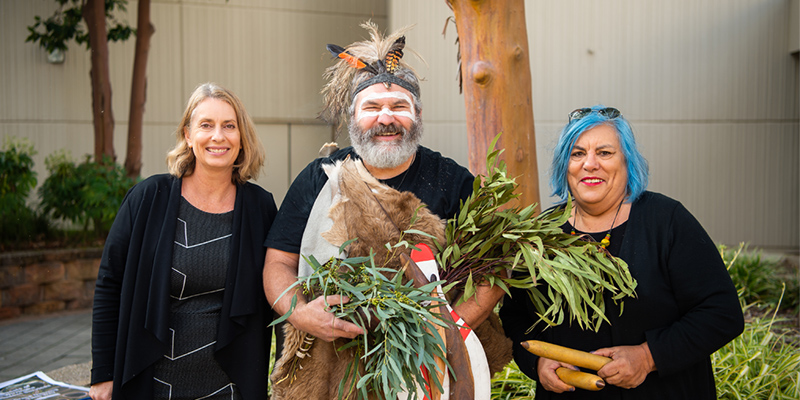 INSIDE UNISA (L-R) Pro Vice Chancellor: Education, Arts and Social Sciences Professor Joanne Cys, Senior Kaurna Man Mickey Kumatpi O’Brien and Aboriginal Student Engagement Officer Anna Strzelecki at the opening of the Magill facilities.
INSIDE UNISA (L-R) Pro Vice Chancellor: Education, Arts and Social Sciences Professor Joanne Cys, Senior Kaurna Man Mickey Kumatpi O’Brien and Aboriginal Student Engagement Officer Anna Strzelecki at the opening of the Magill facilities.> Strengthening Aboriginal student engagement through football
Refurbished study spaces for Aboriginal students have been unveiled at UniSA’s City East and Magill campuses.
The updated Wirringka Student Centres provide an improved student experience for the University’s growing number of Aboriginal students, while also being more accessible and visible.
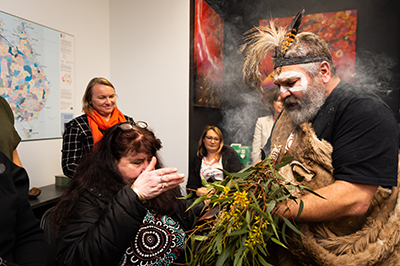 Undertaking the Smoking Ceremony and Cleansing at City East.
Undertaking the Smoking Ceremony and Cleansing at City East.Wirringka Student Services offers Aboriginal and Torres Strait Islander students a friendly, comfortable and supportive place to study and are available on all UniSA campuses.
The upgraded Wirringka facilities at Magill and City East opened on 30 July and feature new furniture and a fresh new design incorporating the Wirringka logo and Aboriginal artwork. The new locations are close to student amenities and are more readily identifiable and accessible to students.
The term Wirringka means "together and in common with" in the Kaurna language, and is the name given to the University’s Aboriginal* student support service. Wirringka is committed to providing culturally safe and appropriate support and study spaces for the University’s Aboriginal students. UniSA has almost 500 Aboriginal students and that number is expected to grow.
UniSA Pro Vice Chancellor: Aboriginal Leadership & Strategy Professor Irene Watson says the new locations at City East and Magill help more suitably identify Wirringka as a valued, visible and respected student support service.
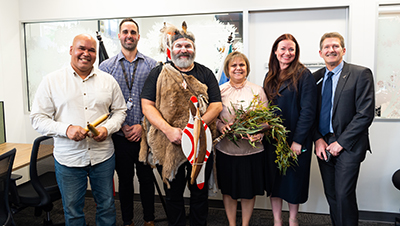 (L-R) Business Project Officer Errol Clarke, Aboriginal Student Engagement Officer Dylan Hunter, Senior Kaurna Man Mickey Kumatpi O’Brien, Manager: Wirringka Student Services Leata Clarke, Division Executive Officer: Health Sciences Emily Adcock and Pro Vice Chancellor: Health Sciences Professor Roger Eston at City East.
(L-R) Business Project Officer Errol Clarke, Aboriginal Student Engagement Officer Dylan Hunter, Senior Kaurna Man Mickey Kumatpi O’Brien, Manager: Wirringka Student Services Leata Clarke, Division Executive Officer: Health Sciences Emily Adcock and Pro Vice Chancellor: Health Sciences Professor Roger Eston at City East.“With the opening of these spaces, UniSA is delivering on its commitment to Aboriginal Education, which is one of the key pillars of our Reconciliation Action Plan,” Prof Watson says.
“The University has a long history of Aboriginal Education – over 50 years – and the Reconciliation Action Plan outlines a range of projects to ensure that we continue to improve the support programs and facilities available for Aboriginal students. Through this commitment, we aim to enable the next generation of Aboriginal scholars and to advance strong Aboriginal futures.”
The 18-month project involved stakeholders from Wirringka, the Student Engagement Unit, the Facilities Management Unit, the City East and Magill divisional and pro vice chancellors’ offices and external consultants. The project, valued at more than $500,000, complements an upgrade of the Wirringka space at City West completed in 2017.
The project also enables the spaces to be used for a greater range of purposes, providing customised support for Aboriginal students and greater flexibility in their mode and location of study, including spaces for study pod work and tutoring activities via the Aboriginal Tutorial Program. The new hubs contribute to UniSA’s aspiration to be the University of Choice for Aboriginal People and are able to host activities including shared lunches and Elders in Residence programs.
Esteemed artist Jonathon Warrior, creator of the Wirringka logo, kindly allowed motifs of his artwork to be used across the spaces, which included the installation of a striking 3D adaptation of the logo in the City East campus space.
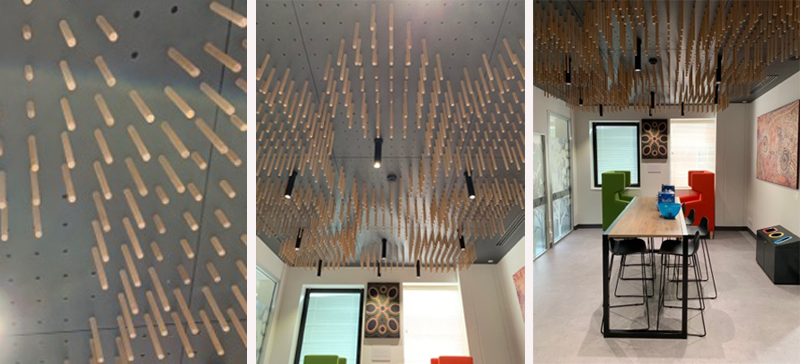 The refurbished facilities at City East include a striking 3D adaptation of the Wirringka logo – ceiling art.
The refurbished facilities at City East include a striking 3D adaptation of the Wirringka logo – ceiling art.The newly-refurbished sites were launched by Senior Kaurna Man Mickey Kumatpi O’Brien, who provided a Welcome to Country and Smoking Ceremony in dedicating the spaces in a culturally meaningful and significant way. Each site held a successful event with students, staff, community members and Elders, members of the University’s Senior Management Group and project contributors.
The Wirringka City East study centre is located in the Playford Building, Level 3, Room 38. The Magill study centre is located in the CA Building.
*Reference to Aboriginal students/people is intended to be inclusive of both Australian Aboriginal and Torres Strait Islander Peoples.
Strengthening Aboriginal student engagement through football
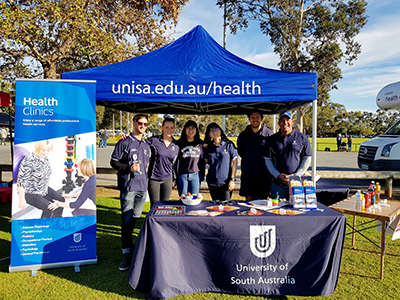
UniSA staff and students shared their knowledge with the wider community at the Aboriginal Junior Football Carnival earlier year.
Nutritionist and lecturer Michael Watkins, student engagement officer Ella Renfrey and Health Sciences project officer Errol Clarke, attended the South Australian Aboriginal Junior Football Carnival at Argana Park (Elizabeth Downs) in June in an effort to strengthen relationships between the University and broader Aboriginal community.
The event was also an opportunity for UniSA students to get outside the classroom and practice engaging and sharing some of their knowledge with the wider community.
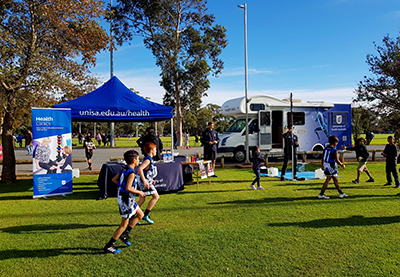
Students who volunteered to take part included Robert Kostic (Exercise Physiology and Food Science), Yee Fang (Food Science) and LiQin Fam (Nutrition).
The junior football carnival attracts hundreds of players and spectators from all over the region. In between games, students led exercise activities including the sit and reach test; the strength test; and the elevated jump test. Players and spectators of all ages also learnt about the sugar content in popular drinks and received a piece of fruit for visiting the UniSA stall. Staff and students were impressed with the level of athletic ability demonstrated on the day.
Other Stories
- A midnight snack might be the key to working overnight
- Memory warning to those wanting to spice up their lives
- Study indicates causal link between obesity and multiple diseases
- Dragonflies are helping make driverless cars safer
- From the Vice Chancellor
- Achievements and Announcements
- Sixteen images that will change how you view research
- Technology preventing hospital falls explained through animation
- Refurbished spaces for Aboriginal students open at City East and Magill
- Healthy lifestyle may counteract genetic risk of dementia
- Video: See highlights from the first six months of 2019
- UniSA visual artist represented on world stage at Cairo Biennale
- Students and staff to provide a ‘hand up’ to help the homeless
- The latest books from UniSA researchers
- UniNationals and Crows lunch




